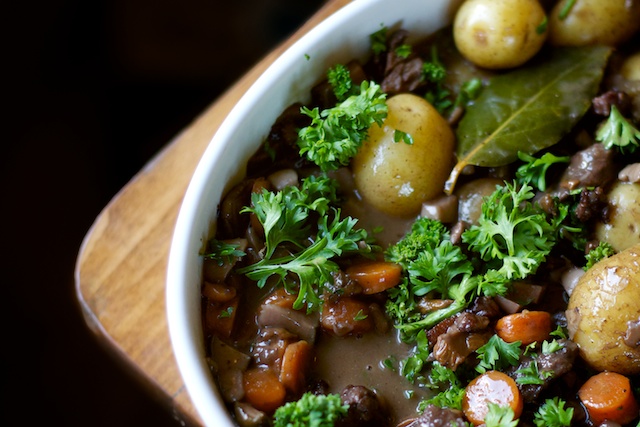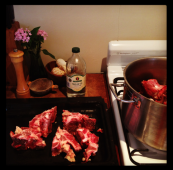I’ve mentioned on twitter that I’ve been making bone broth and some of you asked for the details. And so I oblige! I’ve become a big fan for a bunch of overwhelming reasons I’ll outline below. Sally Fallon introduced me to the stuff in Nourishing Traditions and since then I’ve followed a community of people who can’t stop raving about it. A lot of nutritionists steer their clients to simply drink bone broth. That’s it. The stuff is so full of good stuff…who needs supplements?

Making it is easy and cheap, albeit not very attractive. See the pics below, or this from Sally Fallon when describing the final stages of cooking: “You will now have a pot of rather repulsive-looking brown liquid containing globs of gelatinous and fatty material. It doesn’t even smell particularly good.”
Nice. But regardless…
I buy the bones from the farmer at the farmer’s market for $2 a bag. But if you’re not near a farmer’s market, your butcher will sell some to you (or give them to you!).
I make a batch and freeze it for soups and stews (in 500ml containers) and also in 200ml serves to drink as a soup, or to use for braising veggies (instead of using oil). You basically use it as you would stock, but it’s richer, more gelatinous and more nutritious.
Here’s a bit of a cheat sheet (if Sally hasn’t scared you off)!
Bone Broth: the deal
Bone broth is like normal stock but made with big, cheap bones which are simmered for a very long time (24 hours-plus). At the end of cooking, a stack of minerals have leached from the bones and into the broth that the bones crumble when pressed lightly.
Why would you?
Because it is soooo good for you.
1. Our immune systems love it.
It’s rich in calcium, magnesium, phosphorus and other trace minerals, which are easily absorbable, thus assisting the immune system. Mark’s Daily Apple has a great article breaking down all the nutrients found in bone broth.
2. It’s great for arthritis and joint pain
It contains glucosamine and chondroiton – which help mitigate the deletorious effects of arthritis and joint pain. Rather than shelling out big bucks for glucosamine-chondroitin and mineral supplements, just make bone broth and other nutritive foods a part of your regular diet.
3. It’s a digestive aid
It helps break down grains, beans, legumes, vegetables and meats and is hydrophilic in nature, which means that it facilitates digestion by attracting digestive juices to food in the gut. Bone broths have been used successfully in treating gastro-intestinal disorders, including hyperacidity, colitis, Crohn’s disease, and infant diarrhea.
4. It rebuilds the gut
Chris Kresser says the gelatin in bone broth helps in repairing the integrity of the gut:
“Homemade bone broth soups are effective in restoring a healthy mucosal lining in the stomach. Bone broth is rich in collagen and gelatin, which have been shown to benefit people with ulcers. It’s also high in proline, a non-essential amino acid that is an important precursor for the formation of collagen.”
5. It combats stress + inflammation.
Which is a boon for AI sufferers. Glycine is an “inhibitory” neurotransmitter, and promotes natural sleep and has a “quieting”, protective antistress action. Read more here.
6. It’s great for thyroid issues
Eating muscle meat with a rich source of gelatin counters the negative effects of methionine, cysteine and tryptophan leading to a more efficient metabolism (healthy thyroid).
7. It’s great for nails, hair and women generally.
Rich in both gelatin and collagen it promotes bone and joint healing in addition to supporting digestion.It helps to support the connective tissue in your body and also helps the fingernails and hair to grow well and strong.
Also it’s super cheap. I just made 3.5 litres of the stuff and then I got excited and added up how much it cost me…ready…$3.90. By using the bones from leftover roast chickens matched with vegetable scraps you’ve saved, you can whittle that paltry sum down even lower.
beef bone broth
This recipe is mostly taken from Sally Fallon’s Nourishing Traditions.
about 2-3kg of bones (beef marrow, knuckle bones, meaty rib, neck bones – whatever the butcher will give you)
about 3-4 litres of cold water
1/2 cup vinegar
2-3 onions, coarsely chopped
3 carrots, coarsely chopped
3 celery stalks, coarsely chopped
several sprigs of fresh thyme, tied together
1 teaspoon dried green peppercorns, crushed or a tsp black peppercorns

Meanwhile, place the meaty bones in a roasting pan and brown at 180C or 350F in the oven. When well browned, add to the pot along with the vegetables.
Add additional water, if necessary, to cover the bones; but the liquid should come no higher than within one inch of the rim of the pot, as the volume expands slightly during cooking.
Bring to a boil. Reduce heat and add the thyme and crushed peppercorns.
Simmer 12-72 hours.

Strain the lot (you’ll need to use tongs our your hands to pull out the bones) into a large bowl. Let cool in the fridge and then…
Operation Remove Fat Layer.
This is a little grose, but somehow satisfying. The congealed fat on top is usually a good 1-2cm thick and you can literally pick it up in chunks (like ice over a pond) and turf it.
Divide into containers and freeze/eat.
Some things to know:
- You brown the meatier of the bones in the oven first to 200 degrees C for 45-90 minutes. Lamb/beef bones give better broth if roasted in the oven first.
- Acid is necessary in order to extract the minerals from the bone. Add some vinegar to aid in leaching these minerals – in particular calcium -and other nutrients from the bones.
- The water should be cold, because slow heating helps bring out flavors.
- Stock will keep several days in the fridge…I mostly freeze it though.
- Boiled down it concentrates and becomes a jellylike fumée or demi-glaze that can be reconstituted into a sauce by adding water.
- For more information Nourished Kitchen is a great resource. Ditto Sally’s Nourishing Traditions.
Some things to do with bone broth:
* Drink it like a soup
* Make this amazing Wild Mushroom stew (picture above).
* Braise vegetables with it. I use a tablespoon or two instead of oil when doing stirfries.
* Gravy!!!
Have you tried bone broth? Any tips or tricks you’d like to share?


